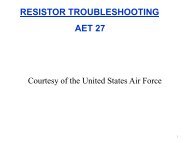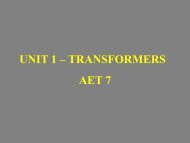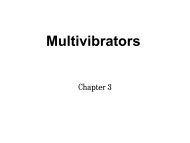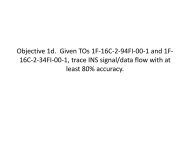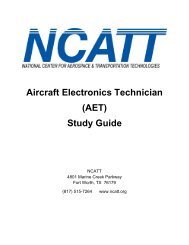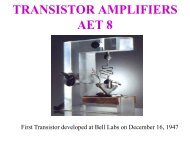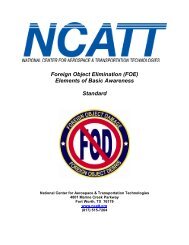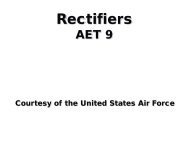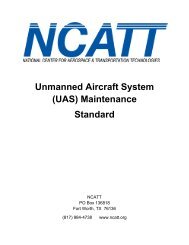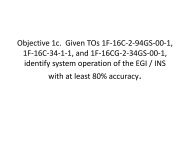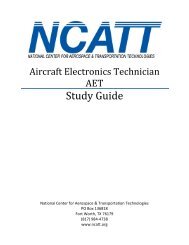Foreign Object Elimination Elements of Basic Awareness ... - NCATT
Foreign Object Elimination Elements of Basic Awareness ... - NCATT
Foreign Object Elimination Elements of Basic Awareness ... - NCATT
Create successful ePaper yourself
Turn your PDF publications into a flip-book with our unique Google optimized e-Paper software.
Page 9 <strong>of</strong> 16<br />
• Tool Condition—Assuring that a tool’s condition is clean, undamaged and free <strong>of</strong> <strong>Foreign</strong> <strong>Object</strong>s<br />
prior to use is a pr<strong>of</strong>essional FOD prevention method. It is very important to visually inspect tools for<br />
all the conditions described herein. Tool condition inspections should be accomplished prior to and<br />
immediately after job completion.<br />
o<br />
o<br />
o<br />
o<br />
Broken or Worn Tools—Visually inspect tools for broken or worn areas that can become FOD.<br />
Damaged—Any damaged tools should be repaired or replaced to prevent the damaged tool from<br />
becoming FOD.<br />
Dirty—Ensure the tools are clean and ready for use prior to each use.<br />
Flaking— (Chrome flaking) Flaking is a hidden <strong>Foreign</strong> <strong>Object</strong> and can become a serious<br />
problem if undetected.<br />
• Sponge Count—A formal procedure utilizing a written record <strong>of</strong> all items entering and leaving a work<br />
area. The medical industry uses this procedure to ensure that all surgical materials that are taken into<br />
a surgical operation area are properly accounted for at the end <strong>of</strong> the surgical procedure. Thereby<br />
preventing FOD (a sponge, surgical tool, etc.) from accidentally being introduced or left inside a<br />
patient. Applying the “sponge count” methodology in aerospace industry settings ensures that foreign<br />
objects (Critical FO) are not left inside aerospace products, assemblies or vehicles.<br />
• Electronic Tool Accountability System—Tools can be tracked to a user by a unique identifier such as<br />
a badge. The electronic tool accountability system utilizes electronic sensors and/or bar codes that<br />
identify each individual tool (see “Tool Identification” in this section).<br />
Student <strong>Object</strong>ive:<br />
The student will identify the relationship <strong>of</strong> basic facts and state general principles about the different types <strong>of</strong><br />
tool accountability utilized by the aviation and aerospace industry.<br />
Standard #4 - Hardware Accountability<br />
<strong>NCATT</strong> Training Standards Level (B)<br />
Equivalent FAA Part 147 Level (2)<br />
Instructional <strong>Object</strong>ive:<br />
Identify the relationship <strong>of</strong> basic facts and state general principles about Hardware Accountability and describe<br />
the methods for controlling hardware. The instructor will explain each <strong>of</strong> the following methods for controlling<br />
hardware.<br />
• Kitted Hardware<br />
• Hardware Removal, Control and Replacement<br />
• Hardware Storage<br />
• Tote Trays and Containers<br />
Instructional Content:<br />
• Hardware – A general term for all <strong>of</strong> the small components, such as nuts, bolts, screws, and washers<br />
used to assemble aerospace components, products and vehicles.<br />
• Kitted Hardware—A kit that contains the exact amount <strong>of</strong> hardware assigned to perform a specific<br />
task. For example, to build a harness the exact amount <strong>of</strong> hardware, wire, plastic ties, and wrapping to<br />
complete the task is supplied to the technician. Use <strong>of</strong> kitted hardware ensures the technician has no<br />
spare hardware, and must use all <strong>of</strong> the hardware that is provided in the kit to successfully complete<br />
Copyright © 2009 by the National Center for Aerospace & Transportation Technologies. All rights reserved.<br />
Individuals may download, print, and make copies <strong>of</strong> this document<br />
for their own personal use. Commercial use prohibited.




